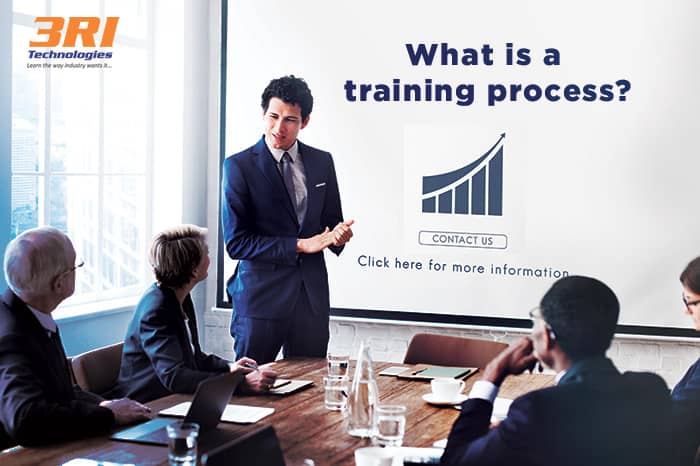As a short-term process, Training is typically led by management and focuses on the requirements for employees to understand and use specific processes and operatives. Alternatively, development is meant for executives and is an ongoing process that helps develop management skills and personalities. Any organization that wants to achieve a certain level of excellence should invest smartly and wisely in upskilling its employees. That is where the training and development process comes in.
Understanding what is the training and the process of training is crucial for any organization aiming to boost employee performance. The training process in HRM involves structured steps designed to identify skill gaps, deliver relevant learning, and measure effectiveness. These training processes ensure employees stay updated and motivated. At 3RI Technologies, our expert Corporate Training programs help you master the steps in the training process to drive real business outcomes. Whether you’re new or experienced in HRM, knowing the steps in training process equips you to build impactful learning initiatives that foster growth and efficiency.
An organization that invests in training shows that it values its employees and the organization’s growth and development. Each stage/phase of the training process needs to be carefully planned and developed to create a supportive workplace for all employees. Now you will exactly understand what the training process is.
Explore the Essential Steps in the Training Process for Effective Learning
Employee changes, changes in tasks, or poor performance can all create the need for training. Each employee of the organization needs to go through this training. The second type of training is designed for specific individuals within the organization. The third type of training addresses the needs of employees assuming a new role within the organization.
One-time training, recurring training, continuous training, or changeable training over time are all possibilities. Depending on the requirements, the training could be short- or long-term. Appraisals, supervisor assessments, self-assessments, peer reviews, systematic investigations, and structured assessments are used to identify training needs. To know the principles you must know about what is the process of training and development.
A Framework for Developing a Training Process
- A trainee must be motivated to learn.
- Relevance of the training material is essential.
- To avoid boredom and fatigue, the training should be varied.
- As soon as the employees complete their training, they should begin applying what they learned.
- Trainees must have access to well-organized, well-presented, and easily accessible training materials.
- Typically, training should be conducted in short sessions spread out over a long period.
- You must take feedback from the trainees to improve the training skills.
To learn the training process you should be aware of the stages or phases of training development through the training cycle. Additionally, During the training cycle, a training program is developed, delivered, and continuously improved. A systematic approach ensures better training results. The training cycle begins long before a training session and extends long after the training process is over. As well as training, it includes stages of planning, developing, and reviewing.
The training cycle is divided into the following phases/stages:
- Identification and assessment of the training requirements
- Designing of the training program
- Development of the training program
- Delivery of the training
- Application in learning
- Reviewing the training program
The first phase of the training cycle helps determine whether training is needed and, if so, what exactly the goal is. It saves a great deal of time, effort, and money to identify the requirements accurately. In the second stage, a training program can be designed based on the training requirements, and a decision can be made about how it should be delivered, such as instructor-led, blended, on-the-job, etc.
This stage involves developing the training program, using materials such as PowerPoint presentations, team activities, job aids, assessments, etc. The delivery stage is when the training is delivered according to the plan.
After the training is completed, the trainees will be able to apply their knowledge in their working environment. Thus, the employees have the opportunity to review and evaluate whether the training was helpful to them, allowing the organization to improve the training program. After covering all the required stages, the next process should be on your mind that what is a training needs analysis.
Organizational Training Requirements
Analysis of Organizational Structure
Analyzing an organization’s objectives, growth potential, resource base, environment, and other external factors is called organizational analysis. It is a determining factor for the type of training that needs to be implemented to maximize effectiveness.
Analysis of the task
Task analysis involves the systematic investigation of all aspects of a task and how to accomplish it. As an example, task assignment, complexity, detailed manual, and mental activity descriptions, work environment conditions, task frequency, task durations, required clothing, and so on.
Analysis of human resources
After considering internal and external factors, manpower analysis determines an activity’s manpower requirements. An organization’s economic, technological, social, and political environments could influence these factors.
To train the manpower, certain quality standards must be met, including:
- Training required in specific areas
- Timeframe for training
- Whether employees are capable of learning new skills
- Designing and redesigning jobs with new methods and technologies
After analysis of requirements, find what is the first step in developing an effective training program? The training program can be executed successfully with it. Training and Development Processes should be planned, organized, and conceptualized for optimum implementation, efficiency, and effectiveness. All participants’ capabilities should be considered during the planning process, including operational-level planning.
If you are looking for a career coach who can solve your career-related queries kindly visit – Best Career Counseling
The training process includes the following steps:
- Identifying objectives
- Training strategies, content, materials, and appropriate evaluation techniques
- Knowledge and skills of trainees
- Format of training
- Pay attention to behavioral aspects
- Training aids and instructional procedures
- Curve of learning
Identifying and assessing training needs is the first step in developing a program. An organization’s strategic plan, human resources plan, or individual development plan may already identify employee training needs. Developing a training program from scratch will require you to choose which areas to focus on.
You will be able to identify any gaps in your current training initiatives and employee skill sets through the training needs assessments. It is important to analyze these gaps, prioritize them, and develop training objectives for the organization. To bridge the performance gap between current and desired performance, a training program should be developed. Training should match the improvement areas at the employee level. It might come to your mind about what is the other name of the training process for that training development is introduced. Usually driven by an organization’s Human Resource Development function, employee training, and development is sometimes called Human Resource Development (HRD). HRD consists of two major types of opportunities:
Development of employees
Implementing internal education programs that improve employee growth and retention is an effective strategy to improve business outcomes.
Development of management skills
The ongoing improvement of certain knowledge, skills, and abilities allows employees to become managers and managers to become effective leaders.
Based on analysis of the training process you have to define what the need for training assessment is.
To get trained by Industry experts and learn more about the courses which can help you to create a brighter career ahead, learn more about the classes at 3RI Technologies
Training Program Objectives
- To prevent the organization from becoming obsolete
- To improve the skills of employees in an effective and systematic manner
- Updating the employees with the latest updates and technologies and ensuring overall performance improvement
- To enhance knowledge needed to perform specific tasks
- Providing employees with diverse skills to make them capable of handling a variety of tasks
- To create a positive impression of the organization among employees
- To educate and instruct employees on efficient handling of equipment, materials, and plant resources
- Employees will be trained on resource conservation, waste prevention, and pollution prevention
- Ensure the safety in equipment handling and occupational health
- Introducing the management skills in the employees to help them take up higher responsibilities and positions
When you achieve all the objectives for the training process or in between any objective you find the conflict. To get out of it you must know to resolve it for that you have the awareness about what is the first step in conflict resolution and what are the skills needed for Conflict Resolution.
The answer is mediation skills. Subordinates who conflict can be guided to identify mutually agreeable changes in behavior by their supervisor. Assured. Empathetic. Capable of making decisions. Empathetic. Understanding. Sincerity.
Step first is all about Defining the source of the conflict that where it comes from. If you have the root cause of the problem you will be more comfortable in resolving the conflict.
As a managing head, you must listen to both sides and allow them to clear their expressions. It will give both the team the way to express themselves and most importantly help you to evaluate the right one. As you listen to each disputant, acknowledge the information, and encourage both sides to continue to open up to you. Sometimes there is only doubt of conflict that it might be or it might not be.
The “Perceived Stage” is described when the people involved in a conflict become fully aware and clear that there is a conflict for sure, for that the Management will now go over to speak with the employee about it
1. Define the source of the conflict. You will learn more if you know the source of the conflict.
2. Take a step back from the incident. In many cases, the situation is not the problem, but the point of view of the problem.
3. Ask for a solution. We then need to get each party’s perspective on how.
4. Find solutions that can be supported by both disputants. You are listening for a solution that is acceptable to both parties.
5. A negotiated agreement is the goal. Mediators sometimes go so far as to write out contracts specifying actions and time frames.
A good training and development program should be designed taking the organization’s requirements, the employees’ skills, the end-goals, and their job profiles into consideration.




